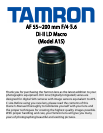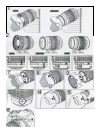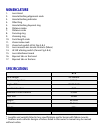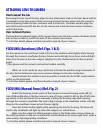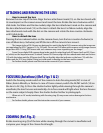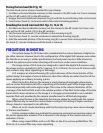
Storing the lens hood (Ref. Fig. 12)
The lens hood can be reverse-mounted for easy storage.
1. For Nikon or Konica Minolta cameras, set the camera to the MF mode. For Canon cameras,
set the AF-MF switch (14) to the MF position.
2. Engage the hood attachment bayonet ring (5) with the hood attaching tabs on the hood.
3. Turn the lens hood (1) clock-wise until it clicks into the locking position.
Detaching the stored lens hood (Ref. Figs. 13, 14, & 15)
1. For Nikon and Konica Minolta cameras, set the camera to the MF mode. For Canon cam-
eras, set the AF-MF switch (14) to the MF position.
2. Set the zoom index mark (11) at 200mm on the zooming ring (9).
3. Turn the lens hood (1) counter-clockwise to extend the focusing ring (8).
4. Hold the extended portion of the focusing ring (8) to secure from moving while turning
the hood (1) counter-clockwise until the hood is released.
PRECAUTIONS IN SHOOTING
The optical design for Di-II takes into consideration the various features of digital sin-
gle reflex cameras. However, due to the configuration of the digital SLR cameras, even when
the Autofocus accuracy is within specifications, the focal point may be a little forward or
behind the optimum point when shooting with auto focus under some conditions.
The image circles of Di-II lenses are designed to match the digital SLR cameras using
the image sensors equivalent to APS-C (approx. 15.5 x 23.2mm). Do not use Di-II lenses with
such cameras may cause vignetting on the image.
A13 employs an internal focusing (IF) system. Because of the characteristics of this
optical design, the angles of view at distances other than infinity are wider than that of the
lenses applying an ordinary focusing system.
When the built-in flash on the camera is used, adverse photographic phenomena
such as corner illumination, fall-off, or vignetting at the bottom part of the image may be
observed, especially with wide angle ranges. This is due to the inherent limitation of the
coverage of the built-in flash, and/or the relative position of the flash to the edge of the lens
barrel which causes shadows on the image. It is strongly recommended to use a suitable
separate flash unit provided by the camera manufacturer for all flash photography.
When using the lens in the telephoto focal range, please be careful with the camera
shake. Effective way to avoid the camera shake is using an ISO setting of higher numbers.
Using a tripod or monopod is also effective.
When set on AF mode, interfering with the focusing ring may cause serious damage
to the lens mechanism.
Certain camera models may indicate the maximum and minimum aperture values of
the lenses appropriate numbers. This is inherent to the design of the camera and not an
indication of error.
When using a special filter such as a PL filter on the A16, use low-profile filters.The
thick rim of a normal filter may cause vignetting.



